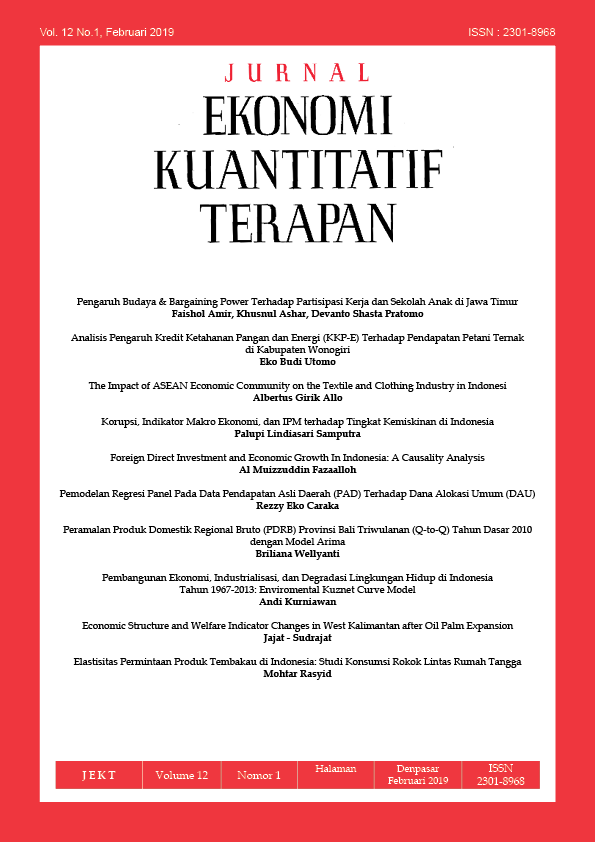The Impact of ASEAN Economic Community on the Textile and Clothing Industry in Indonesia
Abstract
ASEAN Economic Community (AEC) has implemented in 2015. Implementation of AEC means there will be freedom of movement of goods, labor, and capital among the members of the AEC. This study aims to evaluate the impact of the implementation of AECs in the textile and clothing (T&C) industry in Indonesia. We used computable general equilibrium (CGE) model with model GTAP version 8 to evaluate this impact. This study showed that the country will enjoy the greatest benefits of the liberalization of the T&C industry of AEC regions are Vietnam, followed by Thailand and Indonesia.
Downloads
References
Akmal M.S., Ahmad Q.M., Ahmad M.H., Butt M.S. (2007) An empirical investigation of the relationship between trade liberalization and poverty reduction: A case for Pakistan. The Lahore Journal of Economics 12 (1):99-118.
Amiti M., Khandelwal A.K. (2013) Import competition and quality upgrading. Review of Economics and statistics 95 (2):476-490.
ASEAN Secretariat. (2011) ASEAN Economic Community Factbook. The ASEAN Secretariat, Public Outreach and Civil Society Devision, Jakarta.
Balassa B. (1965) Trade liberalisation and “revealed” comparative advantage. The Manchester School 33 (2):99-123.
Breinlich H. (2008) Trade liberalization and industrial restructuring through mergers and acquisitions. Journal of International Economics 76 (2):254-266.
Brockmeier M. (2001) A graphical exposition of the GTAP model. GTAP Technical Papers, Center for Global Trade Analysis, Purdue University, West Lavayette:5.
Busse M., Gröning S., Groening S. (2012) Assessing the impact of trade liberalization: The case of Jordan. Journal of Economic Integration 27 (3):466-486.
Chemingui M.A., Dessus S. (2008) Assessing non-tariff barriers in Syria. Journal of Policy Modeling 30 (5):917-928.
Dixit A., Norman V. (1980) Theory of international trade: A dual, general equilibrium approach. Cambridge University Press.
Dixon P.B., Jorgenson D.W. (2013) Handbook of Computable General Equilibrium Modeling: Volume 1A. North-Holland.
Dollar D., Kraay A. (2004) Trade, growth, and poverty. The Economic Journal 114 (493).
Eichengreen B., Gullapalli R., Panizza U. (2011) Capital account liberalization, financial development and industry growth: A synthetic view. Journal of International Money and Finance 30 (6):1090-1106.
Fan H., Li Y.A., Yeaple S.R. (2015) Trade liberalization, quality, and export prices. Review of Economics and statistics 97 (5):1033-1051.
Fernandes A.M. (2007) Trade policy, trade volumes and plant-level productivity in Colombian manufacturing industries. Journal of International Economics 71 (1):52-71.
Fry J. (2010) ASEAN: regional trends in economic integration, export competitiveness, and inbound investment for selected industries. United States International Trade Commission, Washington, DC.
Goldberg P.K., Pavcnik N. (2007) Distributional effects of globalization in developing countries. Journal of Economic Literature 45 (1):39-82.
Ishido H. (2004) The Economic Impact of Trade Liberalization on the ASEAN Plus Three: The Case of Textile Industry. APEC Study Center Working Paper Series 03/04-No.3, Institute of Developing Economies, Japan.
Kawai M., Wignaraja G. (2011) Asian FTAs: Trends, prospects and challenges. Journal of Asian Economics 22 (1):1-22.
Melitz M.J., Ottaviano G.I. (2008) Market size, trade, and productivity. The Review of Economic Studies 75 (1):295-316.
Mishkin F.S. (2009a) Globalization and financial development. Journal of development economics 89 (2):164-169.
Mishkin F.S. (2009b) Globalization, macroeconomic performance, and monetary policy. Journal of Money, Credit and Banking 41 (s1):187-196.
Nicita A. (2009) The price effect of tariff liberalization: Measuring the impact on household welfare. Journal of development economics 89 (1):19-27.
Nickerson M., Konings J. (2007) Trade liberalization, intermediate inputs, and productivity: Evidence from Indonesia. The American Economic Review 97 (5):1611-1638.
Oladipo O.S. (2011) Does trade liberalization cause long run economic growth in Mexico? An empirical investigation. International Journal of Economics and Finance 3 (3):63.
Parikh A., Stirbu C. (2004) Relationship between trade liberalisation, economic growth and trade balance: An econometric investigation. Hamburgisches Welt-Wirtschafts-Archiv (HWWA) Discussion Paper 282.
Petri P.A., Plummer M.G., Zhai F. (2012) ASEAN economic community: A general equilibrium analysis. Asian Economic Journal 26 (2):93-118.
Sala-i-Martin X.X. (1997) I just ran two million regressions. The American Economic Review:178-183.
Santos‐Paulino A., Thirlwall A.P. (2004) The impact of trade liberalisation on exports, imports and the balance of payments of developing countries. The Economic Journal 114 (493):F50-F72.
Shaikh N.A., Shah P. (2014) Price Effects of Trade Openness on Traded and Non-Traded Goods in Pakistan: An Application of H-O-S 2x2x2 Model. International Journal of Economics, Commerce and Management II (8):1-17.
Shepherd B., Wilson J.S. (2009) Trade facilitation in ASEAN member countries: Measuring progress and assessing priorities. Journal of Asian Economics 20 (4):367-383.
Wangke H. (2014) Peluang Indonesia dalam masyarakat ekonomi Asean 2015. Info Singkat Hubungan Internasional Pusat Pengkajian VI (10):5-8.
Wiersema M.F., Bowen H.P. (2008) Corporate diversification: The impact of foreign competition, industry globalization, and product diversification. Strategic Management Journal 29 (2):115-132.
Winchester N. (2009) Is there a dirty little secret? Non-tariff barriers and the gains from trade. Journal of Policy Modeling 31 (6):819-834.
Yean T.S., Das S.B. (2015) The ASEAN economic community and conflicting domestic interests: An overview. Journal of Southeast Asian Economies (JSEAE) 32 (2):189-201.




















